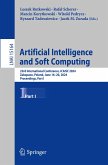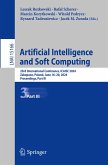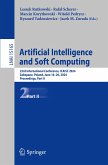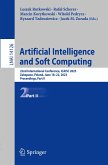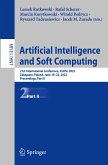Artificial Intelligence and Soft Computing
24th International Conference, ICAISC 2025, Zakopane, Poland, June 22-26, 2025, Proceedings, Part III
Herausgegeben:Rutkowski, Leszek; Scherer, Rafal; Korytkowski, Marcin; Pedrycz, Witold; Tadeusiewicz, Ryszard; Zurada, Jacek M.
Artificial Intelligence and Soft Computing
24th International Conference, ICAISC 2025, Zakopane, Poland, June 22-26, 2025, Proceedings, Part III
Herausgegeben:Rutkowski, Leszek; Scherer, Rafal; Korytkowski, Marcin; Pedrycz, Witold; Tadeusiewicz, Ryszard; Zurada, Jacek M.
- Broschiertes Buch
- Merkliste
- Auf die Merkliste
- Bewerten Bewerten
- Teilen
- Produkt teilen
- Produkterinnerung
- Produkterinnerung
This volume constitutes the proceedings of 24th International Conference on Artificial Intelligence and Soft Computing, ICAISC 2025, Zakopane, Poland, during June 22 26, 2025.
The 83 full papers included in this book were carefully reviewed and selected from 163 submissions.They are organized in topical sections as follows:
Part I - Neural Networks and Their Applications; Fuzzy Systems and Their Applications; Evolutionary Algorithms and Their Applications.
Part II - Computer Vision, Image and Speech Analysis; Data Mining; Pattern Classification and Artificial Intelligence in Modeling…mehr
Andere Kunden interessierten sich auch für
![Artificial Intelligence and Soft Computing Artificial Intelligence and Soft Computing]() Artificial Intelligence and Soft Computing62,99 €
Artificial Intelligence and Soft Computing62,99 €![Artificial Intelligence and Soft Computing Artificial Intelligence and Soft Computing]() Artificial Intelligence and Soft Computing62,99 €
Artificial Intelligence and Soft Computing62,99 €![Artificial Intelligence and Soft Computing Artificial Intelligence and Soft Computing]() Artificial Intelligence and Soft Computing50,99 €
Artificial Intelligence and Soft Computing50,99 €![Artificial Intelligence and Soft Computing Artificial Intelligence and Soft Computing]() Artificial Intelligence and Soft Computing50,99 €
Artificial Intelligence and Soft Computing50,99 €![Artificial Intelligence and Soft Computing Artificial Intelligence and Soft Computing]() Artificial Intelligence and Soft Computing50,99 €
Artificial Intelligence and Soft Computing50,99 €![Artificial Intelligence and Soft Computing Artificial Intelligence and Soft Computing]() Artificial Intelligence and Soft Computing61,99 €
Artificial Intelligence and Soft Computing61,99 €![Artificial Intelligence and Soft Computing Artificial Intelligence and Soft Computing]() Artificial Intelligence and Soft Computing57,99 €
Artificial Intelligence and Soft Computing57,99 €-
-
-
This volume constitutes the proceedings of 24th International Conference on Artificial Intelligence and Soft Computing, ICAISC 2025, Zakopane, Poland, during June 22 26, 2025.
The 83 full papers included in this book were carefully reviewed and selected from 163 submissions.They are organized in topical sections as follows:
Part I - Neural Networks and Their Applications; Fuzzy Systems and Their Applications; Evolutionary Algorithms and Their Applications.
Part II - Computer Vision, Image and Speech Analysis; Data Mining; Pattern Classification and Artificial Intelligence in Modeling and Simulation.
Part III - Various Problems of Artificial Intelligence; Agent Systems, Robotics and Control, Bioinformatics, Biometrics and Medical Applications and Concurrent Parallel Processing.
The 83 full papers included in this book were carefully reviewed and selected from 163 submissions.They are organized in topical sections as follows:
Part I - Neural Networks and Their Applications; Fuzzy Systems and Their Applications; Evolutionary Algorithms and Their Applications.
Part II - Computer Vision, Image and Speech Analysis; Data Mining; Pattern Classification and Artificial Intelligence in Modeling and Simulation.
Part III - Various Problems of Artificial Intelligence; Agent Systems, Robotics and Control, Bioinformatics, Biometrics and Medical Applications and Concurrent Parallel Processing.
Produktdetails
- Produktdetails
- Lecture Notes in Computer Science 15950
- Verlag: Springer / Springer Nature Switzerland / Springer, Berlin
- Artikelnr. des Verlages: 978-3-032-03710-7
- Seitenzahl: 372
- Erscheinungstermin: 1. November 2025
- Englisch
- Abmessung: 235mm x 155mm x 21mm
- Gewicht: 564g
- ISBN-13: 9783032037107
- ISBN-10: 3032037107
- Artikelnr.: 74944670
- Herstellerkennzeichnung
- Springer-Verlag GmbH
- Tiergartenstr. 17
- 69121 Heidelberg
- ProductSafety@springernature.com
- Lecture Notes in Computer Science 15950
- Verlag: Springer / Springer Nature Switzerland / Springer, Berlin
- Artikelnr. des Verlages: 978-3-032-03710-7
- Seitenzahl: 372
- Erscheinungstermin: 1. November 2025
- Englisch
- Abmessung: 235mm x 155mm x 21mm
- Gewicht: 564g
- ISBN-13: 9783032037107
- ISBN-10: 3032037107
- Artikelnr.: 74944670
- Herstellerkennzeichnung
- Springer-Verlag GmbH
- Tiergartenstr. 17
- 69121 Heidelberg
- ProductSafety@springernature.com
.- Various Problems of Artificial Intelligence.
.- Evaluating Scalability in Open-Set Face Recognition Systems.
.- Magic Numbers: Algorithm for Mitigating Hallucinations in LLMs.
.- Lightweight Anomaly Detection for IoT: Evaluating Machine Learning
and Deep Learning Models on CICIDS2017.
.- A survey on algorithms used for drone energy consumption modelling.
.- Extension to LIBLINEAR s Logistic Regression Supporting Elastic-Net
Penalty.
.- LoRa Device Identification: A Lightweight Alternative to CNN-Based
Methods.
.- Enhanced Graph Deviation Networks for Anomaly Detection in Space
Telemetry.
.- Hybrid Retrieval in RAG: A Comparison of Semantic, Lexical and
Reranking Methods.
.- Analysis of Data and Supervised Machine Learning Algorithms for
Intrusion Detection.
.- AI-Driven Tourist Destination Recommendation Systems: A Neural
Network Approach.
.- Privacy-Preserving Inference for Public Neural Networks.
.- Use of graph-based knowledge organization to improve the results of
Retrieval Augmented Generation for narrative texts.
.- Using frequent subgraph mining in flat layout quality classification.
.- Adaptive Interactive Process Drift Detection: Detecting and visualizing
process drifts.
.- Agent Systems, Robotics and Control.
.- Distributed Variational Autoencoder Using Actor-Based Architecture.
.- A Comprehensive Framework for Turn-Taking Evaluation in
Multi-Agent Systems: Rotational Periodicity for Scalable Coordination
Analysis.
.- Application of Adaptive PSO Algorithm in Design of FIR Filters.
.- Bioinformatics, Biometrics and Medical Applications.
.- Novel Method for ICG Data Augmentation By Using Noise-Based
Approach.
.- A Statistical Reconstruction Algorithm for CT with a Flying Focal
Spot Using Direct, Interpolation-Free Projections.
.- Optimizing OpenMax Parameters for Open-Set Face Recognition.
.- Taxonomic Classification of Spiders (Araneae) Based on Image Texture
Analysis Using Multifiltering.
.- A Hybrid Handcrafted and Deep Transfer Learning-Based Framework
for COVID-19 Detection Using Voice Analysis.
.- A modified method for an iterative reconstruction algorithm utilizing a
back-projection correlation approach in multi-focus low-dose tomography.
.- Emotions and App-supported Artificial Intelligence as a Helpful Tool
in Psychiatry.
.- Dermoscopy-specific XAI for melanoma recognition.
.- Analysis of Respiratory Sinus Arrhythmia with Neural Networks.
.- A method for verifying dynamic signatures based on signature regions.
.- Concurrent Parallel Processing.
.- Efficiently Parallelized Associative Inference of Associative Graph Data
Neural Networks.
.- Evaluating Scalability in Open-Set Face Recognition Systems.
.- Magic Numbers: Algorithm for Mitigating Hallucinations in LLMs.
.- Lightweight Anomaly Detection for IoT: Evaluating Machine Learning
and Deep Learning Models on CICIDS2017.
.- A survey on algorithms used for drone energy consumption modelling.
.- Extension to LIBLINEAR s Logistic Regression Supporting Elastic-Net
Penalty.
.- LoRa Device Identification: A Lightweight Alternative to CNN-Based
Methods.
.- Enhanced Graph Deviation Networks for Anomaly Detection in Space
Telemetry.
.- Hybrid Retrieval in RAG: A Comparison of Semantic, Lexical and
Reranking Methods.
.- Analysis of Data and Supervised Machine Learning Algorithms for
Intrusion Detection.
.- AI-Driven Tourist Destination Recommendation Systems: A Neural
Network Approach.
.- Privacy-Preserving Inference for Public Neural Networks.
.- Use of graph-based knowledge organization to improve the results of
Retrieval Augmented Generation for narrative texts.
.- Using frequent subgraph mining in flat layout quality classification.
.- Adaptive Interactive Process Drift Detection: Detecting and visualizing
process drifts.
.- Agent Systems, Robotics and Control.
.- Distributed Variational Autoencoder Using Actor-Based Architecture.
.- A Comprehensive Framework for Turn-Taking Evaluation in
Multi-Agent Systems: Rotational Periodicity for Scalable Coordination
Analysis.
.- Application of Adaptive PSO Algorithm in Design of FIR Filters.
.- Bioinformatics, Biometrics and Medical Applications.
.- Novel Method for ICG Data Augmentation By Using Noise-Based
Approach.
.- A Statistical Reconstruction Algorithm for CT with a Flying Focal
Spot Using Direct, Interpolation-Free Projections.
.- Optimizing OpenMax Parameters for Open-Set Face Recognition.
.- Taxonomic Classification of Spiders (Araneae) Based on Image Texture
Analysis Using Multifiltering.
.- A Hybrid Handcrafted and Deep Transfer Learning-Based Framework
for COVID-19 Detection Using Voice Analysis.
.- A modified method for an iterative reconstruction algorithm utilizing a
back-projection correlation approach in multi-focus low-dose tomography.
.- Emotions and App-supported Artificial Intelligence as a Helpful Tool
in Psychiatry.
.- Dermoscopy-specific XAI for melanoma recognition.
.- Analysis of Respiratory Sinus Arrhythmia with Neural Networks.
.- A method for verifying dynamic signatures based on signature regions.
.- Concurrent Parallel Processing.
.- Efficiently Parallelized Associative Inference of Associative Graph Data
Neural Networks.
.- Various Problems of Artificial Intelligence.
.- Evaluating Scalability in Open-Set Face Recognition Systems.
.- Magic Numbers: Algorithm for Mitigating Hallucinations in LLMs.
.- Lightweight Anomaly Detection for IoT: Evaluating Machine Learning
and Deep Learning Models on CICIDS2017.
.- A survey on algorithms used for drone energy consumption modelling.
.- Extension to LIBLINEAR s Logistic Regression Supporting Elastic-Net
Penalty.
.- LoRa Device Identification: A Lightweight Alternative to CNN-Based
Methods.
.- Enhanced Graph Deviation Networks for Anomaly Detection in Space
Telemetry.
.- Hybrid Retrieval in RAG: A Comparison of Semantic, Lexical and
Reranking Methods.
.- Analysis of Data and Supervised Machine Learning Algorithms for
Intrusion Detection.
.- AI-Driven Tourist Destination Recommendation Systems: A Neural
Network Approach.
.- Privacy-Preserving Inference for Public Neural Networks.
.- Use of graph-based knowledge organization to improve the results of
Retrieval Augmented Generation for narrative texts.
.- Using frequent subgraph mining in flat layout quality classification.
.- Adaptive Interactive Process Drift Detection: Detecting and visualizing
process drifts.
.- Agent Systems, Robotics and Control.
.- Distributed Variational Autoencoder Using Actor-Based Architecture.
.- A Comprehensive Framework for Turn-Taking Evaluation in
Multi-Agent Systems: Rotational Periodicity for Scalable Coordination
Analysis.
.- Application of Adaptive PSO Algorithm in Design of FIR Filters.
.- Bioinformatics, Biometrics and Medical Applications.
.- Novel Method for ICG Data Augmentation By Using Noise-Based
Approach.
.- A Statistical Reconstruction Algorithm for CT with a Flying Focal
Spot Using Direct, Interpolation-Free Projections.
.- Optimizing OpenMax Parameters for Open-Set Face Recognition.
.- Taxonomic Classification of Spiders (Araneae) Based on Image Texture
Analysis Using Multifiltering.
.- A Hybrid Handcrafted and Deep Transfer Learning-Based Framework
for COVID-19 Detection Using Voice Analysis.
.- A modified method for an iterative reconstruction algorithm utilizing a
back-projection correlation approach in multi-focus low-dose tomography.
.- Emotions and App-supported Artificial Intelligence as a Helpful Tool
in Psychiatry.
.- Dermoscopy-specific XAI for melanoma recognition.
.- Analysis of Respiratory Sinus Arrhythmia with Neural Networks.
.- A method for verifying dynamic signatures based on signature regions.
.- Concurrent Parallel Processing.
.- Efficiently Parallelized Associative Inference of Associative Graph Data
Neural Networks.
.- Evaluating Scalability in Open-Set Face Recognition Systems.
.- Magic Numbers: Algorithm for Mitigating Hallucinations in LLMs.
.- Lightweight Anomaly Detection for IoT: Evaluating Machine Learning
and Deep Learning Models on CICIDS2017.
.- A survey on algorithms used for drone energy consumption modelling.
.- Extension to LIBLINEAR s Logistic Regression Supporting Elastic-Net
Penalty.
.- LoRa Device Identification: A Lightweight Alternative to CNN-Based
Methods.
.- Enhanced Graph Deviation Networks for Anomaly Detection in Space
Telemetry.
.- Hybrid Retrieval in RAG: A Comparison of Semantic, Lexical and
Reranking Methods.
.- Analysis of Data and Supervised Machine Learning Algorithms for
Intrusion Detection.
.- AI-Driven Tourist Destination Recommendation Systems: A Neural
Network Approach.
.- Privacy-Preserving Inference for Public Neural Networks.
.- Use of graph-based knowledge organization to improve the results of
Retrieval Augmented Generation for narrative texts.
.- Using frequent subgraph mining in flat layout quality classification.
.- Adaptive Interactive Process Drift Detection: Detecting and visualizing
process drifts.
.- Agent Systems, Robotics and Control.
.- Distributed Variational Autoencoder Using Actor-Based Architecture.
.- A Comprehensive Framework for Turn-Taking Evaluation in
Multi-Agent Systems: Rotational Periodicity for Scalable Coordination
Analysis.
.- Application of Adaptive PSO Algorithm in Design of FIR Filters.
.- Bioinformatics, Biometrics and Medical Applications.
.- Novel Method for ICG Data Augmentation By Using Noise-Based
Approach.
.- A Statistical Reconstruction Algorithm for CT with a Flying Focal
Spot Using Direct, Interpolation-Free Projections.
.- Optimizing OpenMax Parameters for Open-Set Face Recognition.
.- Taxonomic Classification of Spiders (Araneae) Based on Image Texture
Analysis Using Multifiltering.
.- A Hybrid Handcrafted and Deep Transfer Learning-Based Framework
for COVID-19 Detection Using Voice Analysis.
.- A modified method for an iterative reconstruction algorithm utilizing a
back-projection correlation approach in multi-focus low-dose tomography.
.- Emotions and App-supported Artificial Intelligence as a Helpful Tool
in Psychiatry.
.- Dermoscopy-specific XAI for melanoma recognition.
.- Analysis of Respiratory Sinus Arrhythmia with Neural Networks.
.- A method for verifying dynamic signatures based on signature regions.
.- Concurrent Parallel Processing.
.- Efficiently Parallelized Associative Inference of Associative Graph Data
Neural Networks.




